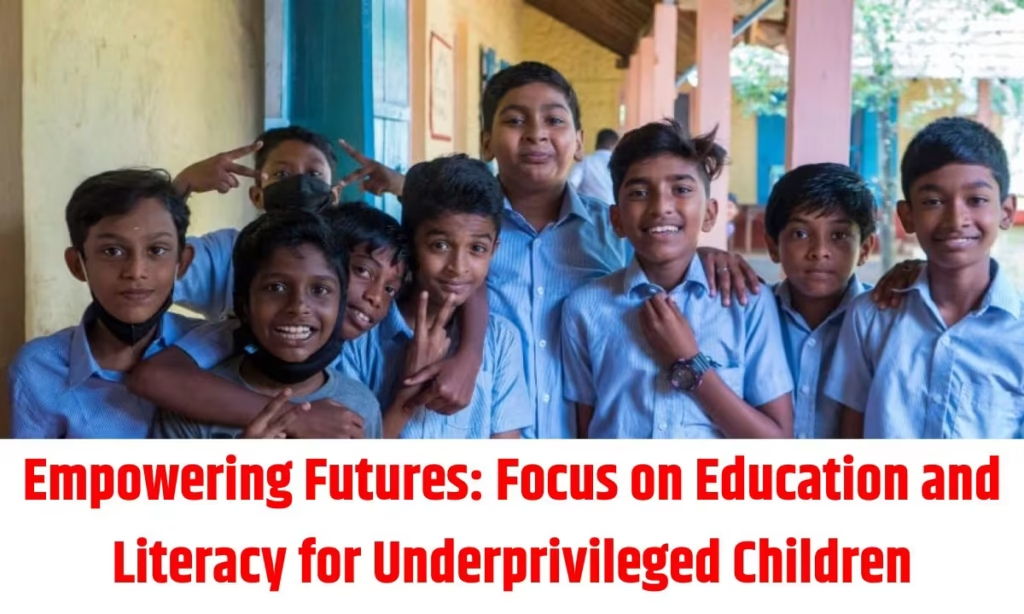Education and Literacy for Underprivileged Children: In a world where knowledge is power, millions of children from underprivileged backgrounds are still locked out of basic education and literacy opportunities. Imagine a young girl in a rural village, dreaming of becoming a doctor but unable to read a simple book because her family can’t afford school fees. This isn’t just a story—it’s the reality for countless kids worldwide. Education and literacy aren’t luxuries; they’re lifelines that can break cycles of poverty and open doors to brighter futures.
In this article, we’ll know why education matters for underprivileged children, the hurdles they face, inspiring success stories, and practical ways we can all make a difference. Whether you’re a parent, teacher, or concerned citizen, this guide will equip you with insights to understand and support this critical cause.
Why Education is a Game-Changer for Underprivileged Kids
Education is more than just learning ABCs or math—it’s the foundation for personal growth, economic stability, and social progress. For underprivileged children, who often come from low-income families, remote areas, or marginalized communities, access to quality education can transform lives. Studies show that every additional year of schooling can increase a person’s income by up to 10%, helping families escape poverty traps.
Think about it: literate children grow into adults who can read job applications, understand health information, and participate in civic duties like voting. Without literacy, they’re vulnerable to exploitation, poor health decisions, and limited job prospects. In underprivileged settings, education fosters resilience. It teaches problem-solving, critical thinking, and creativity—skills that empower kids to innovate in their communities. For instance, in many developing regions, educated youth are leading local initiatives, from sustainable farming to small businesses, proving that investing in education yields long-term dividends for society.
Moreover, education promotes equality. Underprivileged children, especially girls and those from ethnic minorities, face systemic barriers. By prioritizing literacy programs, we level the playing field, ensuring no child is left behind based on their birthplace or family income. It’s not just about individual success; educated populations drive economic growth, reduce crime rates, and build healthier societies. As we explore further, you’ll see how addressing education gaps can create ripple effects that benefit everyone.
Common Challenges in Accessing Education
Underprivileged children encounter a myriad of obstacles that hinder their path to literacy and learning. Poverty is the biggest culprit—families struggling to put food on the table often can’t afford uniforms, books, or transportation to school. In some cases, children are pulled out of class to work in fields, factories, or homes, contributing to household income instead of building their own futures.
Geographical barriers add another layer. Rural or slum areas might lack schools altogether, or existing ones could be overcrowded with underpaid teachers and inadequate resources. Natural disasters, conflicts, or pandemics exacerbate this, as seen in recent years when school closures widened learning gaps for the most vulnerable.
Cultural and social norms also play a role. In certain communities, early marriages for girls or biases against educating children with disabilities limit opportunities. Language barriers further complicate matters; many underprivileged kids speak minority dialects at home, making standard school curricula feel alien and discouraging.
Health issues tie into this too. Malnutrition, lack of clean water, and untreated illnesses mean children can’t focus in class or attend regularly. Without basic literacy, parents might not recognize the value of education, perpetuating the cycle. Overcoming these challenges requires targeted interventions, from free meal programs to community outreach, to make education truly accessible.
Inspiring Literacy Programs Making a Difference
Around the globe, innovative programs are stepping up to bridge the education divide for underprivileged children. Take Room to Read, a nonprofit focused on literacy in Asia and Africa. They’ve built libraries, trained teachers, and distributed millions of books, helping over 20 million children gain reading skills. Their approach emphasizes local languages and gender equality, ensuring girls aren’t overlooked.
In India, the Pratham Education Foundation runs low-cost learning centers in slums, using simple tools like flashcards and games to teach basic reading and math. Their annual surveys highlight progress, showing how even short interventions can boost literacy rates dramatically. Similarly, in Latin America, programs like Brazil’s Bolsa Familia link financial aid to school attendance, reducing dropout rates while supporting families economically.
Africa has seen successes too, with initiatives like Camfed in Zimbabwe, which provides scholarships, mentoring, and life skills training to girls from poor rural families. Graduates often return as community leaders, multiplying the impact. These programs prove that with creativity and commitment, literacy can flourish even in resource-scarce environments. They incorporate fun elements, like storytelling sessions and digital apps, to keep kids engaged and excited about learning.
What makes these efforts stand out is their holistic view—they don’t just teach reading; they build confidence, health awareness, and vocational skills. By partnering with local governments and communities, they ensure sustainability, turning short-term aid into long-lasting change.
How Technology is Revolutionizing Education Access
In today’s digital age, technology is a powerful equalizer for underprivileged children’s education. Low-cost devices like tablets and smartphones are bringing classrooms to remote areas. Apps such as Khan Academy offer free, interactive lessons in multiple languages, allowing kids to learn at their own pace without needing a physical school.
Solar-powered e-readers, distributed by organizations like Worldreader, provide access to thousands of books in underserved regions. This not only boosts literacy but also reduces the need for printed materials, which can be expensive and hard to transport. During the COVID-19 pandemic, online platforms became lifelines, though they highlighted the digital divide—many underprivileged kids lack internet or devices.
To address this, initiatives like India’s Digital India campaign are expanding broadband in rural areas, while nonprofits donate refurbished laptops. AI-driven tools personalize learning; for example, adaptive software assesses a child’s reading level and suggests tailored exercises. Virtual reality even simulates field trips, exposing kids to worlds beyond their villages.
However, technology isn’t a silver bullet. It must be combined with teacher training and community involvement to be effective. When done right, it empowers underprivileged children to dream big, learning coding or science from global experts without leaving home.
The Role of Governments and NGOs in Promoting Literacy
Governments and non-governmental organizations (NGOs) are pivotal in scaling education efforts for underprivileged children. Policies like free compulsory education, as mandated in many countries, set the framework, but implementation varies. Successful governments invest in infrastructure, like building schools in slums and training teachers in inclusive methods.
NGOs fill gaps where governments fall short. Groups like UNICEF advocate for child rights, running campaigns to enroll out-of-school kids and providing emergency education in conflict zones. They collaborate on data-driven approaches, using surveys to identify high-need areas and measure impact.
Public-private partnerships amplify reach. For instance, corporate sponsors fund scholarships, while tech companies develop educational software. International aid, through bodies like the World Bank, supports large-scale programs in developing nations.
Accountability is key—transparent monitoring ensures funds reach the children. By focusing on equity, these entities address disparities, such as higher dropout rates among indigenous or refugee children. Their combined efforts create ecosystems where literacy thrives, fostering global progress.
Simple Ways You Can Support Education Efforts
You don’t need to be a policymaker to make an impact—everyday actions can support education for underprivileged children. Start by donating to reputable charities; even small contributions buy books or fund scholarships. Volunteering your time, like tutoring online or organizing book drives, directly helps.
Advocacy matters too. Share stories on social media to raise awareness, or petition local leaders for better school funding. If you’re a business owner, partner with NGOs for employee volunteer programs or sponsorships.
Educate yourself and others about the issue—host community events or join global campaigns like International Literacy Day. Supporting fair-trade products can indirectly aid, as they often fund education in producer communities.
Remember, consistency counts. Regular involvement, whether through monthly donations or mentoring, builds lasting change. Your efforts, no matter how small, contribute to a world where every child can read, learn, and succeed.
The Broader Impact of Educating Underprivileged Children
Investing in education for underprivileged children isn’t just charitable—it’s smart economics and social strategy. Literate societies experience lower poverty, better health outcomes, and stronger economies. Educated individuals innovate, starting businesses that create jobs and drive growth.
On a societal level, education reduces inequalities, promotes peace, and combats issues like child labor and exploitation. It empowers communities to address environmental challenges, with literate farmers adopting sustainable practices.
Globally, achieving universal literacy could add trillions to the world economy. It also aligns with sustainable development goals, ensuring future generations inherit a more equitable planet. By prioritizing underprivileged kids, we build inclusive societies where talent flourishes regardless of background.
Conclusion: Education and Literacy for Underprivileged Children
Education and literacy for underprivileged children are more than goals—they’re necessities for a just world. From overcoming poverty’s grip to harnessing technology’s potential, we’ve seen how targeted efforts can ignite hope and progress. The stories of transformed lives remind us that every child deserves a chance to learn and thrive.
But change doesn’t happen in isolation. It’s up to us—individuals, communities, and leaders—to advocate, donate, and participate. Start today: support a local program, share this post, or simply spread awareness. Together, we can unlock doors for millions, building a future where no child’s potential is wasted. Let’s empower tomorrow, one literate mind at a time.
FAQ’s About Education and Literacy for Underprivileged Children
What is the main barrier to education for underprivileged children?
Poverty is the primary barrier, often forcing children into work or preventing access to school supplies and transportation. Other factors include location, cultural norms, and lack of infrastructure.
How can literacy programs help break the cycle of poverty?
Literacy equips children with skills for better jobs, informed decisions, and entrepreneurship, enabling them to lift their families out of poverty and contribute to community development.
Are there free online resources for underprivileged kids to learn?
Yes, platforms like Khan Academy, Duolingo, and Coursera offer free courses. Organizations also provide devices and internet access in targeted areas.
What role do parents play in their child’s education?
Parents can encourage learning at home through reading together, prioritizing school attendance, and seeking community support, even with limited resources.
How effective are government scholarships for underprivileged students?
They can be highly effective by covering costs and incentivizing attendance, but success depends on proper implementation and additional support like mentoring.
Can technology replace traditional schools for these children?
Technology complements but doesn’t fully replace schools; it enhances access, especially in remote areas, but human interaction from teachers remains crucial.
Why is girls’ education particularly important in underprivileged communities?
Educating girls leads to healthier families, delayed marriages, and economic empowerment, with multiplier effects like reduced population growth and community upliftment.

